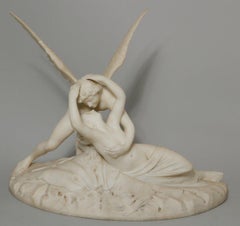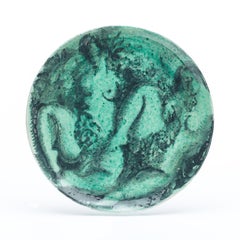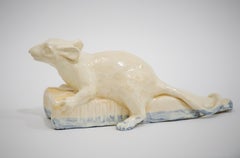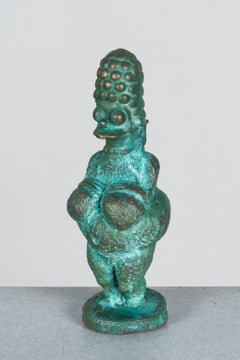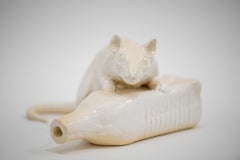Color Nude Sculptures
to
1
1
1
Overall Width
to
Overall Height
to
1
1
1,918
771
551
422
328
308
200
179
97
64
56
40
34
29
28
24
23
22
21
20
1
1
1
1
1
1
Art Subject: Color
Psyche Revived by Cupid's Kiss, Large Marble Sculpture after Canova, 19th C.
Located in Beachwood, OH
After Antonio Canova (Italian, 1757-1822)
Psyche Revived by Cupid's Kiss
Marble
24 x 19 x 16 inches
135 lb.
The love affair between Cupid and Psyche is one of the best known classic...
Category
19th Century Figurative Sculptures
Materials
Marble
"Deux Femmes " . "Naked women " .
By André Masson
Located in CANNES, FR
"Deux femmes nues ". " naked women " is a ceramic plate signed Masson (underneath ) ." unic piece ". dated 1921 .
Andre Masson realized very few works o...
Category
20th Century Art Nouveau Nude Sculptures
Materials
Ceramic
Related Items
Rat On The Bottle In Water - Unique Handmade Glazed Ceramics Sculpture, Portrait
Located in Salzburg, AT
The sculpture is signed below.
Monika Zadurska-Bielak, Graduated from the studio of Prof. Franciszek Duszeńko at the Faculty of Sculpture of the Academy of Fine Arts in Gdansk (dipl...
Category
2010s Contemporary Figurative Sculptures
Materials
Ceramic
H 4.34 in W 9.85 in D 3.55 in
Profundus Bronze Sculpture Nude Boy Contemporary Male Figure Marble Stone
Located in Utrecht, NL
Profundus Bronze Sculpture Nude Boy Contemporary Male Figure Marble Stone
Wim van der Kant (1949, Kampen) is a selftaught artist. Next to his busy p...
Category
21st Century and Contemporary Contemporary Nude Sculptures
Materials
Marble, Bronze
Aquila Bronze Sculpture Nude Boy Marble Stone Contemporary In Stock
Located in Utrecht, NL
Aquila Bronze Sculpture Nude Boy Marble Stone Contemporary In Stock - Sculpture without Stone is 57 cm high
Wim van der Kant (1949, Kampen) is a selftaught a...
Category
21st Century and Contemporary Contemporary Nude Sculptures
Materials
Marble, Bronze
H 27.56 in W 7.88 in D 7.88 in
David Bronze Sculpture Nude Boy Male Figure Marble Stone
Located in Utrecht, NL
David Bronze Sculpture Nude Boy Male Figure Marble Stone
Wim van der Kant (1949, Kampen) is a selftaught artist. Next to his busy profession as a teacher at ...
Category
21st Century and Contemporary Contemporary Figurative Sculptures
Materials
Marble, Bronze
Bust of a young woman / - The Opulence of Beauty -
Located in Berlin, DE
Anton Nelson (i.e. Antoine Joseph van den Kerckhoven) (1849 Brussels - after 1910 ibid.), Bust of a young woman, c. 1890. Patinated bronze on cast base, 30 cm (total height) x 20 cm ...
Category
1890s Art Nouveau Figurative Sculptures
Materials
Bronze
H 11.82 in W 7.88 in D 5.52 in
Modernist Bronze Sculpture of a Nude Woman
Located in Soquel, CA
Abstracted sculpture of a nude woman by Francis Xavier "Frank" Bracken (American, 20th Century). Signed, dated and numbered "Francis X. Bracken 1981 2/7...
Category
1980s Art Nouveau Nude Sculptures
Materials
Bronze, Steel
19th Century Bronze Sculpture "The Letter"
Located in Rochester, NY
Antique bronze sculpture of male nude reading a letter or proclamation. Marble base, 19th century. Unsigned.
Category
Early 19th Century Figurative Sculptures
Materials
Marble, Bronze
Cursus Bronze Sculpture Contemporary Nude Boys Male Figures Marble Stone
Located in Utrecht, NL
Cursus Bronze Sculpture Contemporary Nude Boys Male Figures Marble Stone
Wim van der Kant (1949, Kampen) is a selftaught artist. Next to his busy profession...
Category
21st Century and Contemporary Contemporary Nude Sculptures
Materials
Marble, Bronze
Women figure. I 2013, porcelain, h 17, 5 cm
By Ilona Romule
Located in Riga, LV
Women figure. I
2013, porcelain, h 17,5 cm
by Ilona Romule, leading sculptor in Latvia
''Women Figure" in porcelain is a small-scale sculpture that emb...
Category
2010s Contemporary Figurative Sculptures
Materials
Porcelain
Louvre, Bronze after P. Julien Executed from a Marble Ordered by Marie-Antoinette
Located in Paris, FR
This splendid sculpture represents Young Girl with a Goat (Amalthea and Jupiter's Goat), after the original by Pierre Julien commissioned by Louis XVI in 1785 and completed in 1787 for the cot of Queen Marie-Antoinette in Rambouillet. The work of the sculptor Pierre Julien decorated the interior of a grotto in a pavilion decorated with bas-reliefs by the same sculptor
(acquired by the State by dation in 2003). The work was the main element of a rock basin, which was destroyed during the renovation of the gardens of the small castle.
The same sculpture was seized during the Revolution and exhibited in the Louvre from 1829. The terracotta sketch, which belonged to the collector Ernst May, must have adorned his château de la Couharde (Yvelines) before entering the Louvre's collections in 1920.
The bronze set with a beautiful gilded patina presented here is a work after the original by Pierre Julien (1731-1804) and dates from the 19th century (around 1850).
The superbly preserved sculpture, which has belonged to the same family since its acquisition, is presented on its original base in grey serpentine marble.
The quality of this work is doubly certified:
- on the one hand it is stamped with a round stamp at the top "A. This stamp is a sign of high quality. Achille Collas (1794 - 1859) was the French engineer, engraver and illustrator, inventor among other things of the patented mathematical reduction process of the 19th century to reproduce sculpted objects in reduction, which was very successful. He was awarded a prize at the 1855 exhibition: his "Procédé mécanique", the name under which he prints all his productions, is easily recognisable by the finesse of its execution and by the famous stamp which appears on the base (terrace) of this sculpture.
- On the other hand, an important signature is found on the terrace of the sculpture "F. Barbedienne Fondeur", founder. In 1844, Achille Collas, in order to protect his invention, formed the Société Collas et Barbedienne (Paris) with the art founder Ferdinand Barbedienne (1810-1892), which began to produce and sell famous but smaller sculptures in plaster, wood, bronze or ivory.
The first object to be marketed was the Venus de Milo after the original in the Louvre Museum. Other sculptures such as the sculpture of George Washington, of which a bronze bust was made by the Barbedienne & Process Collas foundry, are currently in the Metropolitan Museum of Art.
HEIGHT OF THE SCULPTURE without base 69CM + BASE = 84CM
WIDTH OF THE SCULPTURE without base 28 CM + BASE = 30,5 CM
LENGTH OF THE SCULPTURE without base 46 CM + BASE 51 CM
The Collas and Barbedienne company was highlighted at the Great Exhibition in London in 1851, the objects of the Barbedienne foundry received a medal and sales soared. At the 1889 Universal Exhibition in Paris, the Barbedienne company again presented a large number of its compositions, including the large neo-Renaissance clock of 1878.
This clock, which was part of the Leblanc-Barbedienne estate, was donated by his heirs to the city of Paris, and is kept in the city hall.
Pierre Julien (20 June 1731 - 17 December 1804) was a French neo-classical sculptor who worked in the full range of rococo and neoclassical styles.
He had an early apprenticeship in Le Puy-en-Velay, near his native village of Saint-Paulien, and then at the École de Dessin in Lyon, before entering the Paris workshop of Guillaume Coustou le Jeune. In 1765, he won the Prix de Rome for sculpture with a bas-relief panel depicting a subject from Antiquity and entered the Royal School for Protected Pupils, which offered a special curriculum under the direction of the painter Louis-Michel van Loo. He was a boarder at the Académie de France in Rome from 1768 to 1773, where he was influenced by the wave of neoclassicism affecting his fellow students. As boarders were required to do, he sent back to France a slightly reduced marble copy of the so-called Cleopatra, the Sleeping Ariadne from the Vatican, which survives in Versailles.
Back in France and with his former master, he worked on the sculpture of the mausoleum of Louis, the Grand Dauphin, in the cathedral of Sens. After a failed attempt in 1776, with his Ganymede, he was accepted by the Royal Academy of Painting and Sculpture in 1778, with a Dying Gladiator. He was appointed one of the first members of the Institut de France in 1795, and knight of the Legion of Honour in 1804.
He was commissioned by the Count of Angiviller, director of the King's Buildings, on behalf of Louis XVI, to paint the figures for a series of life-size portraits of the great men of France: he produced a Jean de La Fontaine and a Nicolas Poussin, whom he chose to depict in a nightgown, similar to the draperies of a Roman toga. While fulfilling commissions in Paris, for the church of Sainte-Geneviève (now the Panthéon, Paris), or for the Pavillon de Flore in the Louvre, he sculpted in 1785 a virtuoso marble set representing the nymph Amalthée and Jupiter's nurse goat for the Queen's Dairy at the Château de Rambouillet; for his model, he adapted the pose of the famous Venus of the Capitoline. The bas-reliefs of the Dairy, considered his masterpieces, were sold at auction in 1819, but were recovered by the State in 2005, thanks to a gift from the son of the great dealer-collector Daniel Wildenstein.
19th century French school, after Pierre Julien (1731-1804)Amalthea and Jupiter's Goat
Bronze with a light brown patina and gilding, reduction made after the marble by Pierre-Julien 1785 executed for Marie-Antoinette at the Laiterie du parc du château de Rambouillet in the Louvre Museum.
Among his major works:
- Dying Gladiator, marble, 1779, Musée du Louvre.
- Ganymede pouring nectar to Jupiter changed into an eagle, [4] marble group, 1776-1778, Paris, Musée du Louvre.
- Jean de La Fontaine, marble, 1783-85. Musée du Louvre
- Nicolas Poussin, marble, 1789 - 1804. Musée du Louvre
- Sketch of a model in terracotta by Nicolas Poussin, ca. 1787 - 1788. Musée du Louvre
- Amalthea and Jupiter's goat, marble group, 1787 for the Rambouillet Dairy. The Queen's Dairy at Rambouillet
- The girl with the goat, terracotta statuette, 1786. Louvre Museum
- Sainte Geneviève restoring her mother's sight, terracotta bas-relief, 1776. Musée du Louvre
The works of the famous sculptor Pierre Julien have been referenced in several books and catalogues, including
The exhibition catalogue. Gilles Grandjean and Guilhem Scherf. "Pierre Julien 1731-1804". Le Puy-en-Velay, France: Musée Crozatier, 2004.
The Lure of Classical Sculpture 1500-1900 (Yale University Press, 1981), cat. no. 24, pp 184-87).
Michael Preston Worley, 2003. Pierre Julien: Sculptor to Queen Marie Antoinette. The first modern monograph.
Europe in the age of enlightenment and revolution, a catalogue from the libraries of the Metropolitan Museum of Art (fully available online in PDF format), which contains information on Julien.
Excerpts from the Grove Dictionary of Art online
Pierre Julien in American Public Collections, on the French Sculpture Census website
STATUE BARE (BODY) NANNY GOAT (ANIMAL) AMALTHAEA SITTING WOMAN
ABOUT US:
AYN GALLERY is located in the heart of old Paris on the Ile Saint-Louis surrounded by the Seine, in the most prestigious district of Paris. Just a few steps away from Notre Dame, like a village, this place preserved from urbanists offers a setting as it existed centuries ago with its numerous private mansions which earned the island the nickname "island of palaces" and its illustrious occupants: Charles Baudelaire, Marie Curie, Georges Pompidou or Camille Claudel
Our gallery is located just opposite one of the oldest churches in Paris. As the eponymous name of the place indicates, Yasmine Azzi, the owner and artistic director of the place, has a keen eye. Born from the desire to bring together, in a unique space, vintage pieces of 20th century design, contemporary creations, original works of art and interior design know-how, AYN GALLERY was created in 2017.
Our gallery presents an eclectic and daring mix, driven by a total freedom of styles and periods. We offer a collection that combines aesthetics and authenticity, in a word what we like and what our customers like.
We offer an inspiring selection of furniture from the last century with rare antiques, but also precious objects and lighting with a special emphasis on vintage Italian...
Category
19th Century Rococo Figurative Sculptures
Materials
Marble, Bronze
H 33.08 in W 18.12 in D 12.01 in
Italian 19th-20th Century Life-Size Marble Sculpture Titled "Searching for Love"
Located in LA, CA
A very fine museum quality Italian 19th-20th century life-size marble sculpture titled "Searching for Love" by Vito Pardo (Italian, born in Venice in 1872) Depicting a semi-nude life...
Category
19th Century Romantic Figurative Sculptures
Materials
Marble, Bronze
Sydney Kumalo Bronze Minimalist African Modernist Sculpture Figural Female Nude
Located in Surfside, FL
Sydney Kumalo. Features a bronze stylized female figural form sculpture fixed to a marble plinth and wood base. Bears signature on base. Measures 9 1/2" x 4 1/4". There is no edition number on the piece.
Sydney Kumalo (1935 - 1988) was born in Sophiatown, Johannesburg, on 13 April 1935. His was one of the families who had to move out of the "white" city to the South Western Townships, or Soweto. Raised in Diepkloof and educated at Madibane High School, he took with him from old Sophiatown the curious and diverse heritage of its heyday. Art classes in the Catholic school, "Sof' town" blues and jazz, the vibrant street culture and growing defiance of its population of various races who were gradually forced out into separate race-group areas. So it was that these various aspects of his early life created for Kumalo a cultural mix of a Zulu family related to the traditional royal house; city schooling, nascent township music and lingo; growing urbanised political defiance and the deep-rooted Zulu pride and respect for the legends and ancient stories of a tribal people. This mix of old and new cultures was reinforced when he began his studies at the Polly Street Art Centre in 1953 where he became a member of Cecil Skotnes group of serious artists who were encouraged to acquire professional skills. Skotnes introduced a basic training programme with modelling as a component, which marked the introduction of sculpting (in brick-clay) at Polly Street.
Kumalo was Skotnes’ assistant at Polly Street from 1957 to 1964, and having recognised his great talent as a sculptor, Skotnes encouraged him to become a professional artist.
After Kumalo’s very successful assistance with a commission to decorate the St Peter Claver church at Seeisoville near Kroonstad, with painting designs, sculpture and relief panels in 1957, Skotnes arranged for Kumalo to continue his art training by working in Edoardo Villa ’s studio from 1958 to 1960. Working with Villa, he received professional guidance and began to familiarize himself with the technical aspects of sculpting and bronze casting. In 1960 he became an instructor at the Polly Street Art Centre.
Kumalo started exhibiting his work with some of the leading commercial Johannesburg galleries in 1958, and had his first solo exhibition with the Egon Guenther Gallery in 1962. He was a leader of the generation who managed to leave behind the forms of African curios, reject the European-held paternalism which encouraged notions of "naive" and "tribal" African art, and yet still hold fast to the core of the old legends and spiritual values of his people. He introduced these subjects into his bronze sculptures and pastel drawings, evolving his own expressive, contemporary African "style".
Together with Skotnes, Villa, Cecily Sash and Giuseppe Cattaneo, Kumalo became part of the Amadlozi group in 1963. This was a group of artists promoted by the African art collector and gallery director Egon Guenther, and characterised by their exploration of an African idiom in their art. Elza Miles writes that Cecil Skotnes’ friendship with Egon Guenther had a seminal influence on the aspirant artists of Polly Street: “Guenther broadened their experience by introducing them to German Expressionism as well as the sculptural traditions of West and Central Africa. He familiarised them with the work of Ernst Barlach, Käthe Kollwitz, Gustav Seitz, Willi Baumeister and Rudolf Sharf.” It is therefore not surprising that some of Kumalo’s sculptures show an affinity with Barlach’s powerful expressionist works. Guenther organised for the Amadlozi group to hold exhibitions around Italy, in Rome, Venice, Milan and Florence, in both 1963 and 1964.
Kumalo’s career took off in the mid 1960s, with his regular participation in exhibitions in Johannesburg, London, New York and Europe. He also represented South Africa at the Venice Biennale in 1966, and in 1967 participated in the São Paulo Biennale.
EJ De Jager (1992) describes Kumalo’s sculpture as retaining much of the “canon and formal aesthetic qualities of classical African sculpture. His work contains the same monumentality and simplicity of form.” His main medium for modelling was terra cotta, which was then cast in bronze, always paying careful attention to the finish of both the model as well as the final cast. He began casting the pieces he modelled in clay or plaster into bronze at the Renzo Vignali Artistic Foundry in Pretoria North. He worked throughout his life with its owners, the Gamberini family, and enjoyed learning the technical aspects of the casting process, refining his surfaces according to what he learned would produce the best results in metal. De Jager further writes that Kumalo’s distinctive texturing of the bronze or terra cotta is reminiscent of traditional carving techniques of various African cultures. “In many respects Kumalo thus innovated a genuine contemporary or modern indigenous South African sculpture”. Kumalo came to admire the works of the Cubists, and of British sculptors Henry Moore and Lynn Chadwick. He became noted for adapting shapes from them into his own figures. The success of his use of the then current monumental simplicity and purely aesthetic abstractions of natural forms has been emulated by many South African sculptors since the 1970s.
He was in many ways the doyen of South African Black art. As such he was an important influence especially on younger African sculptors, by whom he is greatly revered. Through his teaching at Polly Street and at the Jubilee Centre, as well as through his personal example of integrity, dedication and ability, he inspired and guided students who in their own right became outstanding artists, for example, Ezrom Legae, Leonard Matsoso and Louis Maqhubela
From 1969 onward, he allied himself with Linda Givon, founder of The Goodman Gallery in Johannesburg, where he exhibited regularly until his death in December 1988. Working with Givon also perpetuated his associations with his many friends of strong principles. Skotnes, Villa, Legae and later such peers from the Polly Street era as Leonard Matsoso, Durant Sihlali and David Koloane have all exhibited at The Goodman Gallery. Kumalo, Legae, and later Fikile (Magadlela) and Dumile (Feni) were among the leading exponents of a new Afrocentric art...
Category
20th Century Modern Figurative Sculptures
Materials
Marble, Bronze
Previously Available Items
Marge Simpson, Bronze Statue: 'Venus of Margendorf'
By Joshua Goode
Located in New York, NY
The most extraordinary relics discovered by Joshua Goode and the Aurora-Rhoman Institute of Archaeology and Cultural Relics during recent archaeological expeditions. The first eviden...
Category
2010s Contemporary Figurative Sculptures
Materials
Bronze
Rat On The Bottle - Modern Unique Handmade Glazed Ceramics Sculpture, Portrait
Located in Salzburg, AT
The sculpture is signed below.
Monika Zadurska-Bielak, Graduated from the studio of Prof. Franciszek Duszeńko at the Faculty of Sculpture of the Acade...
Category
2010s Contemporary Figurative Sculptures
Materials
Ceramic
H 5.52 in W 9.45 in D 9.06 in
